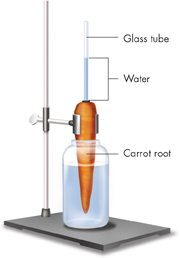The waxy Casparian strip forces water and minerals to move through the cell membranes of endodermis cells rather than in between the cells. This enables the endodermis to filter and control the water and dissolved nutrients that enter the vascular cylinder. More importantly, the Casparian strip ensures that valuable nutrients will not leak back out. As a result, there is a one-way passage of water and nutrients into the vascular cylinder.
Root Pressure Why do plants “need” a system that ensures the one-way movement of water and minerals? That system is how the plant generates enough pressure to move water out of the soil and up into the body of the plant. As minerals are pumped into the vascular cylinder, more and more water follows by osmosis, producing a strong pressure. If the pressure were not contained, roots would expand as they filled with water.
Instead, contained within the Casparian strip, the water has just one place to go—up. Root pressure, produced within the cylinder by active transport, forces water through the vascular cylinder and into the xylem. As more water moves from the cortex into the vascular cylinder, more water in the xylem is forced upward through the root into the stem. In Figure 23–9, you can see a demonstration of root pressure in a carrot root.
Root pressure is the starting point for the movement of water through the vascular system of the entire plant. But it is just the beginning. Once you have learned about stems and leaves, you will see how water and other materials are transported within an entire plant.

FIGURE 23–9 Root Pressure Demonstration In this setup, a glass tube takes the place of the carrot plant's stem and leaves. As the root absorbs water, root pressure forces water upward into the tube.
23.2 Assessment

-
Review How are tissues distributed in a plant root?
Compare and Contrast How is the structure of cells in a root's transport system different from the structure of cells making up the epidermis?
-
Review Describe the main functions of roots.
Explain How is osmosis involved in the absorption of water and nutrients?
c. Apply Concepts Why is it important that the root endodermis permits only a one-way passage of materials?
VISUAL THINKING
Draw a diagram to show how roots absorb water and nutrients. Label the diagram and write brief descriptions of the processes shown.

Table of Contents
- Formulas and Equations
- Applying Formulas and Equations
- Mean, Median, and Mode
- Estimation
- Using Measurements in Calculations
- Effects of Measurement Errors
- Accuracy
- Precision
- Comparing Accuracy and Precision
- Significant Figures
- Calculating With Significant Figures
- Scientific Notation
- Calculating With Scientific Notation
- Dimensional Analysis
- Applying Dimensional Analysis




